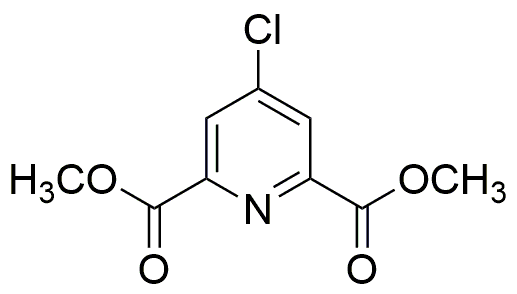Dimethyl 4-Chloro-2,6-pyridinedicarboxylate is widely utilized in research focused on:
- Pharmaceutical Development: This compound serves as a key intermediate in the synthesis of various pharmaceuticals, particularly those targeting neurological disorders, enhancing drug efficacy and specificity.
- Agricultural Chemicals: It is used in the formulation of herbicides and pesticides, helping to improve crop yields by effectively managing weed and pest populations.
- Material Science: The compound is incorporated into polymers and coatings, providing enhanced durability and resistance to environmental stressors, which is beneficial for construction and automotive industries.
- Analytical Chemistry: It acts as a reagent in analytical methods, aiding in the detection and quantification of various substances in complex mixtures, thus supporting quality control processes.
- Biochemical Research: Researchers utilize it to study enzyme interactions and metabolic pathways, contributing to advancements in biochemistry and molecular biology.
General Information
Properties
Safety and Regulations
Applications
Dimethyl 4-Chloro-2,6-pyridinedicarboxylate is widely utilized in research focused on:
- Pharmaceutical Development: This compound serves as a key intermediate in the synthesis of various pharmaceuticals, particularly those targeting neurological disorders, enhancing drug efficacy and specificity.
- Agricultural Chemicals: It is used in the formulation of herbicides and pesticides, helping to improve crop yields by effectively managing weed and pest populations.
- Material Science: The compound is incorporated into polymers and coatings, providing enhanced durability and resistance to environmental stressors, which is beneficial for construction and automotive industries.
- Analytical Chemistry: It acts as a reagent in analytical methods, aiding in the detection and quantification of various substances in complex mixtures, thus supporting quality control processes.
- Biochemical Research: Researchers utilize it to study enzyme interactions and metabolic pathways, contributing to advancements in biochemistry and molecular biology.
Documents
Safety Data Sheets (SDS)
The SDS provides comprehensive safety information on handling, storage, and disposal of the product.
Product Specification (PS)
The PS provides a comprehensive breakdown of the product’s properties, including chemical composition, physical state, purity, and storage requirements. It also details acceptable quality ranges and the product's intended applications.
Certificates of Analysis (COA)
Search for Certificates of Analysis (COA) by entering the products Lot Number. Lot and Batch Numbers can be found on a product’s label following the words ‘Lot’ or ‘Batch’.
*Catalog Number
*Lot Number
Certificates Of Origin (COO)
This COO confirms the country where the product was manufactured, and also details the materials and components used in it and whether it is derived from natural, synthetic, or other specific sources. This certificate may be required for customs, trade, and regulatory compliance.
*Catalog Number
*Lot Number
Safety Data Sheets (SDS)
The SDS provides comprehensive safety information on handling, storage, and disposal of the product.
DownloadProduct Specification (PS)
The PS provides a comprehensive breakdown of the product’s properties, including chemical composition, physical state, purity, and storage requirements. It also details acceptable quality ranges and the product's intended applications.
DownloadCertificates of Analysis (COA)
Search for Certificates of Analysis (COA) by entering the products Lot Number. Lot and Batch Numbers can be found on a product’s label following the words ‘Lot’ or ‘Batch’.
*Catalog Number
*Lot Number
Certificates Of Origin (COO)
This COO confirms the country where the product was manufactured, and also details the materials and components used in it and whether it is derived from natural, synthetic, or other specific sources. This certificate may be required for customs, trade, and regulatory compliance.


